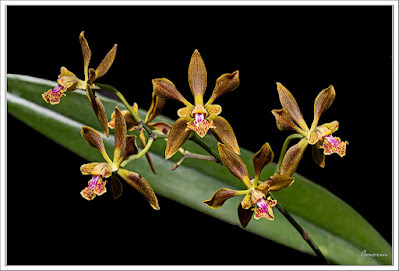Encyclia dressleri - Dressler's Encyclia flowers are showy, resupinate long lasting, open simultaneously, lacking a fragrance; sepals and petals...
Encyclia dressleri, also called as Dressler's Encyclia, is a species in the genus Encyclia. This species was described by Carlos Rommel Beutelspacher Baigts and Iván Moreno Molina in 2018.
DESCRIPTION OF ENCYCLIA DRESSLERI - DRESSLER'S ENCYCLIA
Encyclia dressleri is native to Mexico. It is found growing in tropical dry forests in transition to tropical oak dry forests in the extreme Northwestern section of the Chiapas Highlands at elevations of 1100-1250 meters above sea level.
It is a medium sized, warm growing epiphytic species with 30-45 mm long, suborbicular-ellipsoid to pyriform pseudobulbs that are covered with scarious sheaths. The leaves are 1-2, 16-19.5 × 1.5-3.0 cm, linear lanceolate, acute, basally attenuate, conduplicate in prefoliation, coriaceous, erect to subpatent, often somewhat recurved, shiny green above, dull pale green below
Dressler's Encyclia blooms in spring and summer from the 45-105 cm long, erect to patent, racemose or branched, 6-25 flowered inflorescence that arise from mature pseudobulb. The flowers are 3.5 cm in diameter, showy, resupinate, with the perianth segments spreading, somewhat concave in the middle and arching forward or incurved on the distal half, long lasting, open simultaneously, lacking a fragrance; sepals and petals of dull green or dull yellowish green base color, on the distal half or 2/3 heavily tinged with dull or deep brownish red to orangish, the nerves with much darker lines of dots or streaks, the claw almost entirely of the base color; lip base color dull yellow, the lateral lobes with several (7-9) continuous or broken longitudinal lines or dots of dark maroon over the nerves; central lobe with many broken lines or dots of dark maroon on the warts and nerves, the keels emerging from the callus and covering the proximal 1/2-3/5 of the lobe bright white or pale pink with purple nerves, spots or lines.
ENCYCLIA DRESSLERI - DRESSLER'S ENCYCLIA CARE AND CULTURE
Cultural information should only be used as a guide, and should be to be adapted to suit you. Your physical location; where you grow your plants, how much time you have to devote to their care, and many other factors, will need to be taken into account. Only then can you decide on the cultural methods that best suit you and your plants.
Light:
Encyclia dressleri needs a light level of 25000-35000 lux. The light should be filtered or diffused and the plants should not be exposed to direct midday sun. Strong air movement should be provided all the time.
Temperature:
In summer, the average day temperature is 27-30 °C, and the night 17-19 °C, with a daily amplitude of 8-10 °C. In winter the average daytime temperatures are 25-27 °C, and 16-18 °C during the night, while the daily amplitude is 8-11 °C.
Humidity:
Dressler's Encyclia needs the humidity of 80% in the period of growth, in winter and spring it falls to 60-70%. Too dry air has a negative effect on the development of the plant: its growth is inhibited, and the leaves begin to turn yellow and dry out. The higher temperature, the higher the humidity should be, and the higher the humidity, the more often and longer it is necessary to ventilate the room where the plants are contained, otherwise the probability of rotting and various kinds of fungal diseases. Good air movement is essential while the plants are in leaf and growing.
Substrate, growing media and repotting:
Encyclia dressleri are most often grown in pots or baskets with a very thick, loose and well-drained substrate. There should be plenty of space in the pots to allow the roots to dry quickly after watering. It is recommended to use smaller pots sufficient for only one or two years of growth, because the substrate in larger pots remains wet after watering for too long. Roots that do not dry out quickly enough after watering rot. Most growers recommend medium grain bark, though others prefer medium cork pieces mixed with large lumps of charcoal.
The plants also grow well mounted on tree-fern or cork rootstocks, provided that high humidity is ensured. Fixed plants require high humidity and at least daily watering in summer, and in the case of dry and hot weather, it may be necessary to water several times a day.
Transplanting or splitting is best done when new roots begin to emerge, or immediately after blooming. This allows the plants to acclimate in a relatively short time and provides them with the least stress.
Watering:
The plants should be watered abundantly during active growth, but their roots must dry out quickly after watering. At the end of autumn, the amount of water should be gradually reduced.
Fertilizer:
Dressler's Encyclia should be fertilized every week 1/4-1/2 of the recommended dose of fertilizer for orchids. A fertilizer with a high nitrogen content is beneficial from spring to mid-summer, and a phosphorus-rich fertilizer can be used in late summer and autumn. Higher phosphorus content stimulates better flowering in the next season and promotes hardening of new growth before winter.
To avoid the accumulation of mineral deposits during periods of strong fertilization, it is recommended to rinse the containers approximately every month.
Rest period:
Encyclia dressleri needs a dry rest period in winter. Allow the plants to dry a bit before the next watering, but do not let the remaining ones dry for long periods of time. In most cases, light watering every 2-3 weeks and occasional morning misting between waterings are sufficient. Fertilization should be limited or should be abandoned altogether until spring, when stronger watering resumes.














COMMENTS